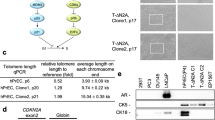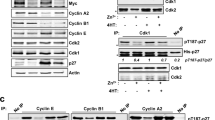Abstract
Malignant transformation of primary cells requires at least two distinct and characteristic alterations in cellular behaviour. The first, cellular immortality1,2, can be induced by chemical carcinogens3 or by cloned oncogenes such as polyoma large T (ref. 4), adenovirus early region 1A (E1A) or the oncogene from avian (MC29) myelocytomatosis virus, v-myc. Cells whose in vitro life-span has been extended by these procedures can be fully transformed by transfection with oncogenes belonging to a different complementation group, including genes of the ras family, adenovirus Elb and polyoma virus middle T (refs 4,5). The unstable cellular phosphoprotein p53 is frequently present at elevated levels in transformed cells6–11 and is stabilized by the formation of complexes with simian virus 40 (SV40) large T or adenovirus Elb 57K protein10–13. Although several reports have associated p53 with cell proliferation14–17, its role remains obscure. We have cloned complementary DNA sequences encoding murine p5318 and report here that transfection of p53 expression constructs into cells of finite lifespan in vitro results in cellular immortality and susceptibility to transformation by a ras oncogene.
This is a preview of subscription content, access via your institution
Access options
Subscribe to this journal
Receive 51 print issues and online access
$199.00 per year
only $3.90 per issue
Buy this article
- Purchase on Springer Link
- Instant access to full article PDF
Prices may be subject to local taxes which are calculated during checkout
Similar content being viewed by others
References
Klein, G. Cancer Res. 19, 343–358 (1959).
Newbold, R. F., Overell, R. W. & Connell, J. R. Nature 299, 633–635 (1982).
Newbold, R. F. & Overell, R. W. Nature 304, 648 (1983).
Ruley, H. E. Nature 304, 602–606 (1983).
Land, H., Parada, L. F. & Weinberg, R. A. Nature 304, 596–602 (1983).
Crawford, L. V., Pim, D. C., Gurney, E. G., Goodfellow, P. & Taylor-Papadimitriou, J. Proc. natn. Acad. Sci. U.S.A. 78, 41–45 (1981).
DeLeo, A. B. et al. Proc. natn. Acad. Sci. U.S.A. 76, 2420–2424 (1979).
Rotter, V. Proc. natn. Acad. Sci. U.S.A. 80, 2613–2617 (1983).
Rotter, V., Boss, M. A. & Baltimore, D. J. Virol. 38, 336–346 (1981).
Lane, D. P. & Crawford, L. V. Nature 278, 261–263 (1979).
Linzer, D. I. H. & Levine, A. J. Cell 17, 43–52 (1979).
McCormick, F. & Harlow, E. J. Virol. 34, 213–224 (1980).
Sarnow, P., Ho, Y. S., Williamms, J. & Levine, A. J. Cell 28, 387–294 (1982).
Milner, J. & McCormick, F. Cell Biol. int. Rep. 4, 663–667 (1980).
Milner, J. & Milner, S. Virology 112, 785–788 (1981).
Mercer, W. E., Nelson, D., DeLeo, A. B., Old, L. J. & Baserga, R. Proc. natn. Acad. Sci. U.S.A. 79, 6309–6312 (1982).
Mercer, W. E., Avignolo, C. & Baserga, R. Molec. cell. Biol. 4, 276–281 (1984).
Jenkins, J. R., Rudge, K., Redmond, S. & Wade-Evans, A. Nucleic Acids Res. 12, 5609–5626 (1984).
Graham, F. L. & Van der Eb, A. J. Virol. 52, 456–461 (1973).
Southern, P. J. & Berg, P. J. molec. appl. Genet. 1, 327–341 (1982).
Gorman, C. M., Merlino, G. T., Willingham, M. C., Pastan, I. & Howard, B. H. Proc. natn. Acad. Sci. U.S.A. 79, 6777–6781 (1982).
Yamamoto, T., de Crombrugghe, B. & Pastan, I. Cell 22, 787–797 (1980).
Konkel, D. A., Tilghman, S. M. & Leder, P. Cell 15, 1125–1132 (1978).
Author information
Authors and Affiliations
Rights and permissions
About this article
Cite this article
Jenkins, J., Rudge, K. & Currie, G. Cellular immortalization by a cDNA clone encoding the transformation-associated phosphoprotein p53. Nature 312, 651–654 (1984). https://doi.org/10.1038/312651a0
Received:
Accepted:
Issue Date:
DOI: https://doi.org/10.1038/312651a0
This article is cited by
-
Shifting the paradigms for tumor suppression: lessons from the p53 field
Oncogene (2021)
-
Updates from the TP53 universe
Cell Death & Differentiation (2018)
-
Therapeutic targeting of p53: all mutants are equal, but some mutants are more equal than others
Nature Reviews Clinical Oncology (2018)
-
Key rates for the grades and transformation ability of glioma: model simulations and clinical cases
Journal of Neuro-Oncology (2017)
-
Overexpression of p53 protein in human tumors
Medical Molecular Morphology (2012)
Comments
By submitting a comment you agree to abide by our Terms and Community Guidelines. If you find something abusive or that does not comply with our terms or guidelines please flag it as inappropriate.



